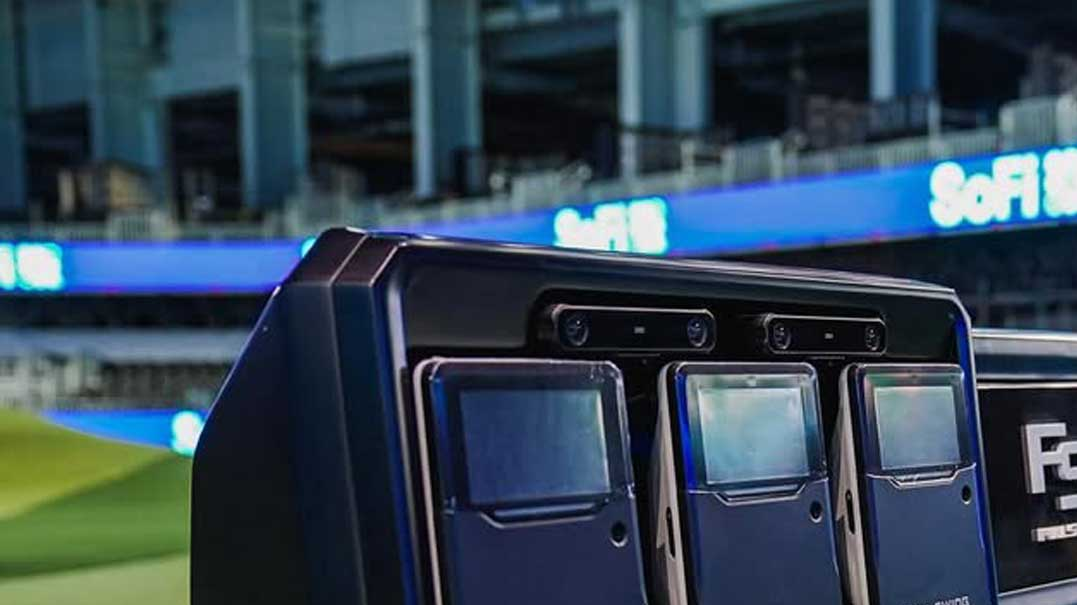
Full Swing has outfitted the SoFi Center with 18 launch monitors for TGL competition.
Full Swing
If there’s one thing Tiger Woods‘ new TGL indoor golf league doesn’t lack, it’s groundbreaking innovations that will allow for a first-of-its-kind virtual golf competition to take place when the league tees off Tuesday night for its inaugural match.
To capture the data of each player’s swings and shots so they can be displayed on the SoFi Center’s massive 64′ by 53′ screen, TGL has partnered with Full Swing to provide all the launch monitors and power the 3,800 square foot putting green where the matches will be won or lost. Full Swing is the same brand Tiger Woods uses for both his personal launch monitors and his home simulator.
In a video on the Full Swing Youtube channel, Full Swing VP of Innovation Evan El-Saden takes viewers behind the scenes of the SoFi Center’s virtual golf stadium:
By: Alan Bastable
To capture the player’s full shots during a TGL match, Full Swing will utilize 18 Full Swing Kit radar-based launch monitors positioned around the SoFi Center. Banks of six Full Swing Kits will be positioned behind both the back box and the front box of the TGL Screenzone. Banks of three more launch monitors are placed in pits to the left and right of the Screenzone.
Both right-handed golfers and left-handed golfers have their own dedicated launch monitors and then there are additional units for redundancy to ensure no shots are missed during competition.
“With 18 of these things being live, they basically talk to each other,” El-Saden said. “So we’re bringing a more robust processing to the unit.”
Each one of the tee boxes for TGL has three different areas to play from, including real fairway grass, rough, and sand. The simulation software sends specific coordinates so the software knows exactly where the next shot will be hit.
 There are dedicated launch monitors for both left- and right-handed players. Full Swing
There are dedicated launch monitors for both left- and right-handed players. Full Swing
El-Saden said they expect to learn new things from the TGL build and potentially bring those learnings to the consumer products too.
Just like a regular simulator you might find at your golf course or put in your home, the software brings the simulation to life to make it look like you’re on a golf course. Full Swing created the software for the TGL simulator as well.
“They kind of roughed out the strategy like what they want it to be on paper, and then we make it three dimensional to make it come to life and play strategically as they wanted it to,” El-Saden said. “So we’re capturing initial launch conditions, things like spin rate, things like club speed, and then we also work in conjunction with Toptracer on the ball flight characterization.”
There’s also a separate screen called the “digital caddie,” where players can see what will be presented on the screen for their next shot and plan it out using a digital yardage book. Players can view slope overlays similar to how it works on a regular golf video game.
Once players are within 50 yards of the hole, play moves to the Greenzone, which is perhaps the most advanced indoor short game area ever created.
Underneath the TGL’s massive 22,475-square-foot short game area are three Full Swing Virtual Green assemblies, which contain 600 actuators that control the undulations of the green. Each assembly is 27′ by 15′ and results in the green having three different teirs.

Between the actuators are three layers of plexiglass and a layer of Dual Flex Rubber before you reach the turf where the ball will land and roll on.
The entire short game area sits on a 41-yard turntable that will rotate based on the holes designed for TGL. Overtop is a spotlight that will pinpoint exactly where the player will play their next shot from, a technology that was completely new for Full Swing to create.
“We created 30 landscapes, so 30 different combinations of how it undulates,” El-Saden said. “And then each hole has it embedded where the pin should be, so when the thing rotates, the green undulates, an official will know exactly which pin placement to use for that hole.”
Thanks to being a semi-virtual league, El-Saden said that allowed the course designers to do things that wouldn’t have been possible on a regular golf course.
“Endless possibilities when you when you really think about making it feel unique and different,” he said. “So do you wanna goto a path left, right, center, you name it, that’s the benefit of having a tech-infused golf league. It allows you for more possibilities because if you just design courses as they are today, it kind of begs a question why do a tech-infused golf league, if you’re not celebrating what tech can do.”



